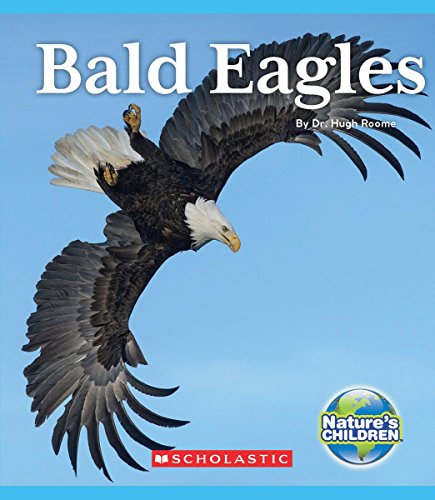-
Polar Bears
Hugh Roome
Paperback (Children's Press, Feb. 1, 2018)Discover why these top predators are at risk due to climate change and loss of habitat.Nature's Children series provides young readers (Ages 8-10) with fascinating information about the planet's most incredible wildlife species. Each title offers a complete picture of the animal- from birth to adulthood- and describes its place in our world, including how humans impact it and its environment. Did you know that polar bears have transparent fur that only looks white-or that these giant carnivores are excellent swimmers? R
R
-
Hammerhead Sharks
Vicky Franchino
Paperback (Childrens Pr, Sept. 1, 2014)Describes the physical characteristics, behavior, and habitat of hammerhead sharks. R
R
-
Owls
Josh Gregory
Paperback (Scholastic, Jan. 1, 2013)With their strange faces and nocturnal habits, owls have long captured the imaginations of people around the world. Readers will discover how these feathered flyers swoop down to snatch prey in their talons, blend in with their environments, and work together to raise their young. They will also learn how some owls are different from others and how humans can help save endangered owl species from disappearing forever. S
S
-
Lions: Kings of the Grasslands
Hugh Roome
Library Binding (Children's Press, Sept. 3, 2019)Did you know that a lion's roar can be heard up to 5 miles away?Nature's Children series provides young readers (Ages 8-10) with fascinating information about the planet's most incredible wildlife species. Each title offers a complete picture of the animal- from birth to adulthood- and describes its place in our world, including how humans impact it and its environment. S
S
-
Armadillos: Dynamite Diggers
Susan Knopf
Paperback (Children's Press, Sept. 3, 2019)Did you know that there are 20 species of armadillo, but only two roll into a ball for protection.Nature's Children series provides young readers (Ages 8-10) with fascinating information about the planet's most incredible wildlife species. Each title offers a complete picture of the animal- from birth to adulthood- and describes its place in our world, including how humans impact it and its environment. R
R
-
Sloths
Josh Gregory
Library Binding (Children's Press, Sept. 1, 2015)The slow-moving sloth spends so much time sitting still that green algae often grows in its fur.Nature's Children series provides young readers (Ages 8-10) with fascinating information about the planet's most incredible wildlife species. Each title offers a complete picture of the animal- from birth to adulthood- and describes its place in our world, including how humans impact it and its environment. Readers will follow these unique mammals as they use their long, strong limbs to climb through the treetops of South America's jungle habitats. They will also discover what sloths eat, how they raise their young, and why they so rarely spend time on the ground. S
S
-
Tigers
Patricia Janes
Paperback (Children's Press, Feb. 1, 2018)Learn how at these stealthy predators are at risk due to illegal hunting.Nature's Children series provides young readers (Ages 8-10) with fascinating information about the planet's most incredible wildlife species. Each title offers a complete picture of the animal- from birth to adulthood- and describes its place in our world, including how humans impact it and its environment. Did you know that a tiger's stripes go all the way to its skin-or that newborn cubs weight about as much as a stick of butter? Learn fascinating facts like these-and more-all in the pages of this book! Q
Q
-
Wolf Spiders
Josh Gregory
Paperback (Scholastic, Sept. 1, 2013)Spiders are known for spinning webs and waiting for unlucky insects to get caught in the sticky strands. Wolf spiders, however, are not so passive. Readers will learn how these skilled hunters stalk and attack prey, just like the much larger animals they are named after. They will also find out how these eight-legged arachnids reproduce, care for their young, and construct their homes. S
S
-
Lions: Kings of the Grasslands
Hugh Roome
Paperback (Children's Press, Sept. 3, 2019)Did you know that a lion's roar can be heard up to 5 miles away?Nature's Children series provides young readers (Ages 8-10) with fascinating information about the planet's most incredible wildlife species. Each title offers a complete picture of the animal- from birth to adulthood- and describes its place in our world, including how humans impact it and its environment. S
S
-
Bald Eagles
Hugh Roome
Library Binding (Children's Press, Sept. 1, 2018)Did you know that the bald eagle can reach speeds of up to 100 mph?Nature's Children series provides young readers (Ages 8-10) with fascinating information about the planet's most incredible wildlife species. Each title offers a complete picture of the animal- from birth to adulthood- and describes its place in our world, including how humans impact it and its environment. Did you know that the bald eagle is one of the largest raptors in the world-or that it can reach speeds of up to 100 mph (160 km/hr) when diving after prey? Learn fascinating facts like these-and more-all in the pages of this book! X
X
-
Leeches
Katie Marsico
Paperback (Children's Press, Sept. 1, 2015)Though they are most famous as parasites that feed by attaching themselves to larger hosts and sucking blood, leeches are actually a diverse group of worms.Nature's Children series provides young readers (Ages 8-10) with fascinating information about the planet's most incredible wildlife species. Each title offers a complete picture of the animal- from birth to adulthood- and describes its place in our world, including how humans impact it and its environment. While some leeches fit the stereotypes, others lead very different lifestyles. Readers will learn all about the world's leeches, from where they live and how they move around to how they reproduce and how they can be beneficial to humans. R
R
